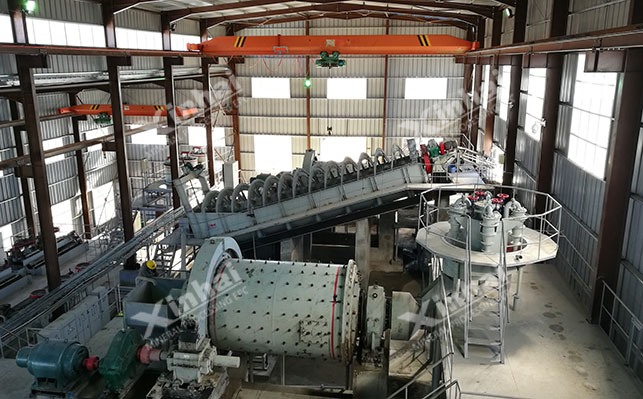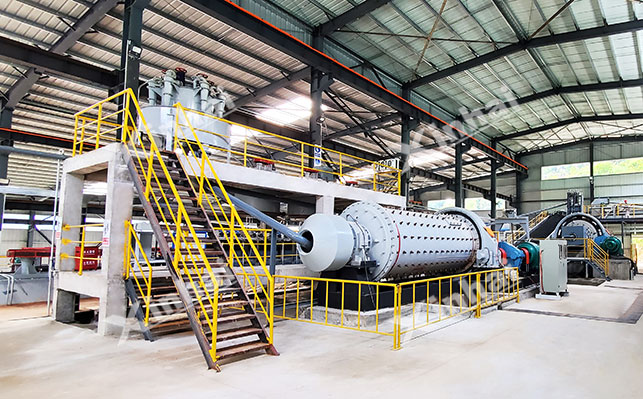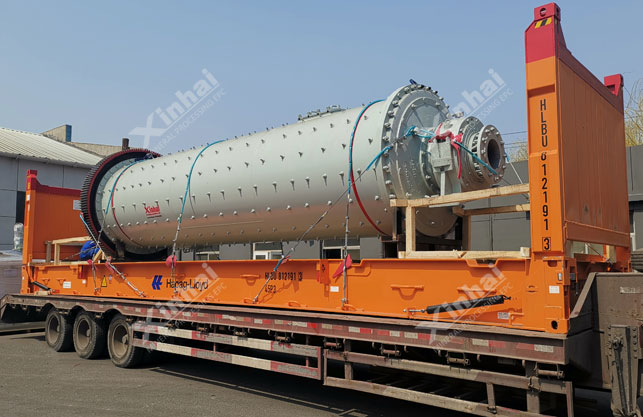
15311826613
Click to add WeChatFluorite (fluorite) is an important non-metallic mineral, which is widely used in many fields such as metallurgy, chemical industry, and building materials. In the process of fluorite beneficiation, flotation is a common and important method, and grinding particle size is one of the key factors affecting the flotation effect of fluorite.
The appropriate grinding particle size can not only improve the monomer dissociation degree of fluorite and gangue minerals, but also has a decisive role in the concentrate grade and recovery rate. Therefore, in-depth understanding of the standards of fluorite flotation grinding particle size and the specific requirements of different fluorite ore flotation for grinding particle size is of great significance to improving fluorite beneficiation efficiency and comprehensive resource utilization.

Grinding particle size is directly related to the monomer dissociation degree of fluorite and gangue minerals, which in turn affects the flotation index. Generally speaking, the fluorite flotation grinding particle size needs to consider many factors to determine the appropriate range.
From the perspective of theory and practical experience, when the flotation particle size is relatively coarse, the flotation selectivity is high, and the fluorite concentrate recovery rate is high, but the concentrate grade is low. This is mainly because the grinding particle size is too coarse, and the fluorite and gangue minerals are often not fully dissociated, and there are intergrowths, which affect the separation and purification of fluorite, resulting in low concentrate grade.
When the flotation particle size is at a medium level, the fluorite concentrate grade and recovery rate can be maintained at a high level at the same time, while when the flotation particle size is fine, the fluorite concentrate grade and recovery rate will usually decrease. This is mainly because the grinding particle size is too fine, which is prone to over-crushing and produces a large amount of ore mud. The ore mud will consume flotation reagents, affect the stability and selectivity of flotation foam, reduce the concentrate recovery rate, and may also make some fluorite particles difficult to effectively float due to changes in surface properties.
In actual production, for most fluorite ores, the grinding fineness is often measured by -0.074mm (200 mesh) content. It is generally believed that when the content of -0.074mm is around 60%-70%, for some fluorite ores with relatively coarse interpenetration and relatively simple mineral composition, it can better balance the concentrate grade and recovery rate. But this is not an absolute standard, and it needs to be adjusted according to factors such as ore characteristics.

Coarse interpenetration particle size: When the interpenetration particle size of fluorite mineral is around 0.5-2mm, the combination of fluorite and gangue minerals in this type of ore is relatively loose. Through conventional grinding means, the grinding fineness is controlled at -200 mesh, accounting for 60-70%, and better monomer dissociation can be achieved, meeting the requirements of conventional flotation method.
Fine interpenetration particle size: If the interpenetration particle size of fluorite mineral is less than 0.1mm, the interpenetration relationship between minerals is close at this time, and finer grinding is required to achieve monomer dissociation of fluorite and gangue minerals. However, fine grinding will inevitably produce more ore slime, which will have a negative impact on the flotation effect. For this type of ore, more caution is needed when determining the grinding particle size. On the one hand, to ensure that fluorite and gangue minerals are fully dissociated as much as possible, it may be necessary to increase the grinding fineness to -200 mesh, accounting for 70% - 80% or even higher; on the other hand, it is necessary to pay attention to the pretreatment of ore slime, such as using a desludging process to first remove some fine slime, reduce the consumption of flotation reagents and interference with the flotation process.
Quartz-type fluorite ore: In the roughing operation, in order to reduce the loss of fluorite in the tailings due to over-grinding, appropriate coarse grinding should be carried out. The grinding fineness can be controlled at -0.074mm with a content of about 50%-60%, so that fluorite and gangue minerals such as quartz are initially dissociated, allowing some monomer fluorite to float out first. In the subsequent selection operation, especially the silicon reduction operation, fine grinding is required to increase the grinding fineness to -0.074mm with a content of 70%-80% or even higher to ensure that the gangue minerals and fluorite are fully dissociated and the grade of the fluorite concentrate is further improved. This is mainly because quartz has a high hardness and a complex intercalation relationship with fluorite, and different grinding finenesses are required at different stages to achieve effective separation.
Calcite and barite type fluorite: This type of fluorite is difficult to flotate because minerals such as calcite and barite have similar floatability to fluorite, and are easily floated out with fluorite during the flotation process, affecting the grade of the concentrate. For this type of fluorite ore, the control of grinding particle size needs to be coordinated with specific flotation processes and reagent systems. Usually, the grinding fineness requirement is relatively high. Generally, it is necessary to reach a -0.074mm content of 70%-85% to ensure that fluorite and these gangue minerals are as fully dissociated as possible. During the flotation process, dextrin or tannin is added to inhibit barite, and baked gum and lignin sulfonate are used to inhibit calcite, so as to achieve effective separation of fluorite and gangue minerals.

Low degree of oxidation: The surface properties of fluorite in this type of ore are relatively stable and have good floatability. Under normal circumstances, it can be controlled according to the conventional grinding particle size standard. The particle size is controlled at -0.074mm, accounting for 60%-70%, which can meet the flotation requirements and achieve good monomer dissociation and flotation indicators. During the flotation process, by reasonably matching collectors and inhibitors, fluorite and gangue minerals can be effectively separated to obtain fluorite concentrate with higher grade and recovery rate.
High degree of oxidation: The surface properties of fluorite after oxidation change, and its floatability is affected. Generally, heated flotation method is required to improve its surface activity and enhance the adsorption effect of collectors. In terms of grinding particle size, in order to better dissociate the oxidized fluorite from the gangue minerals, the grinding fineness needs to be appropriately increased, and the -0.074mm content can be increased to 70%-80%. At the same time, attention should be paid to avoid excessive fine mud during the grinding process.
There is no fixed standard for the grinding particle size of fluorite flotation, which is mostly affected by many factors such as the particle size of fluorite mineral embedding, the type of gangue minerals, and the degree of oxidation. In actual production, it is necessary to conduct in-depth research on the properties of the ore, and determine the grinding particle size suitable for fluorite ore through scientific test methods and comprehensive consideration of cost-effectiveness, so as to ensure that fluorite can be effectively separated from gangue minerals during the flotation process, improve the grade and recovery rate of fluorite concentrate, and improve the comprehensive utilization level of fluorite ore resources, providing a strong guarantee for the sustainable development of related industries.